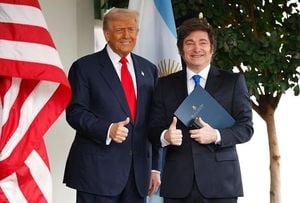Wall Street awoke to a cautiously optimistic mood on October 8, 2025, as U.S. stock futures inched higher and the gold rally showed no signs of losing steam. Investors, still reeling from a sharp reversal in yesterday’s markets and the ongoing government shutdown, turned their focus to the upcoming Federal Reserve minutes for much-needed clarity on the direction of monetary policy.
Futures tied to the Dow Jones Industrial Average rose by 96 points, or 0.2%, according to The Wall Street Journal and Yahoo Finance. The S&P 500 and tech-heavy Nasdaq 100 futures mirrored this modest uptick, each gaining roughly 0.2% in premarket trading. These gains followed a losing session for all three major indexes, which snapped a seven-day streak of record highs on October 7. Analysts pointed to signs of buyer exhaustion and a sudden pause in the artificial intelligence (AI) trade that had been fueling recent exuberance.
Meanwhile, gold futures continued to dazzle. The precious metal settled above $4,000 per ounce for the first time on Tuesday, October 7, and extended its rally by another 1.2% in early Wednesday trading, MarketWatch reported. Silver prices also climbed, closing in on a record not seen since 1980. The surge in gold—and to a lesser extent, bitcoin and other alternative assets—has been dubbed the "debasement trade," as investors seek shelter from mounting concerns over the stability of the dollar and other major currencies.
"Gold continued to be the big winner amid political uncertainty as the price of the precious metal settled above $4,000 for the first time. The haven asset has jumped more than 50% this year in the face of uncertainties over global trade, the Federal Reserve’s independence, and U.S. fiscal stability," MarketWatch noted, capturing the prevailing sentiment among risk-averse investors.
The backdrop to all this market movement is the seventh day of a U.S. government shutdown, which has created a vacuum of economic data. The shutdown not only deprives Wall Street and policymakers of crucial information but also amplifies the importance of any signals from the Federal Reserve. With President Trump threatening to withhold back pay for furloughed workers and no end to the gridlock in sight, the sense of uncertainty is palpable.
"Markets are looking for catalysts amid a lack of economic data while the U.S. government shutdown drags on, which means today’s minutes from last month’s Federal Reserve monetary policy meeting may carry even more weight than usual," The Wall Street Journal observed.
The minutes in question, set to be released this afternoon, cover the Federal Open Market Committee’s (FOMC) September meeting—where the Fed made its first interest rate cut of 2025, lowering rates by a quarter point. The move was not without controversy: Federal Reserve Governor Stephen Miran, a Trump appointee, was the lone dissenting voice. Miran argued that the limited impact of tariffs on inflation means the central bank can continue easing monetary policy, while Minneapolis Fed President Neel Kashkari warned that "any drastic rate cuts would risk stoking prices." This division has left investors guessing about the likelihood of two further rate cuts expected later this year, especially given the current lack of economic data.
Interest-rate futures as of Wednesday morning indicated a 95% chance that the Fed would cut rates again in October, according to The Wall Street Journal. "Market bulls benefited significantly in the past few days amidst a lack of economic figures, however, as multibillion dollar AI deals strengthened sentiment regarding modern technology’s growth potential. While that exuberance has quelled, further upside may emerge from Fed speakers acknowledging that decelerating labor conditions warrant imminent rate cuts across several meetings," wrote Jose Torres, senior economist at Interactive Brokers, in a note cited by MarketWatch.
Technology stocks remained in the spotlight for less celebratory reasons. The sector, which had been leading the charge in recent weeks, was largely responsible for dragging markets lower on Tuesday. Oracle’s disappointing cloud profit outlook weighed heavily, and Tesla shares sank more than 4% after the company launched new versions of its top-selling models priced under $40,000. Critics argued that the lower price tags were still too high to entice new buyers, a sentiment that seemed to resonate across the market.
As the earnings season approaches, many of the tech giants that typically move markets are not expected to report until later in the month. In the meantime, investors are looking to companies like PepsiCo and Delta Airlines, both scheduled to release results tomorrow, for clues about the health of consumer spending and the broader economy—especially in the wake of President Trump’s tariffs.
Elsewhere, the bond market also reflected the air of caution. A $58 billion Treasury auction drew solid demand, but the yield on the benchmark 10-year note edged lower by up to 0.4 basis points, according to Tradeweb data. This was the first such auction since the government shutdown began, and longer-dated Treasury yields in general were inching lower ahead of the event. The WSJ Dollar Index, meanwhile, reached its highest intraday level since August 1, with the dollar strengthening notably against the yen.
Global markets were not immune to the day’s drama. French bond yields led declines in global yields following the resignation of the French prime minister earlier in the week, which also contributed to a weaker euro. European steel stocks, on the other hand, rallied after the European Union unveiled plans to cut tariff-free imports to the bloc—a move seen as supportive for domestic producers.
Back in the U.S., the lack of economic data has left traders and policymakers alike flying somewhat blind. The Federal Reserve, typically reliant on a steady stream of economic indicators to guide its decisions, now finds itself in the unusual position of having to lean more heavily on anecdotal evidence and market signals. This has only heightened the stakes for the release of the September meeting minutes, with investors hoping for any hint of consensus—or at least a clearer sense of the debate—within the central bank.
As Wall Street waits for the Fed’s next move, the mood is one of cautious optimism tempered by a keen awareness of the many risks still lurking beneath the surface. The combination of record gold prices, a surging dollar, and a divided Federal Reserve paints a complex picture of a market searching for stability in uncertain times. For now, with the shutdown dragging on and the data drought showing no sign of abating, all eyes remain fixed on the central bank for direction—and perhaps, a little reassurance.
With investors piling into haven assets and policymakers wrestling with the limits of their own visibility, the days ahead promise to test both nerves and convictions across Wall Street and beyond.




